1993 DODGE TRUCK length
[x] Cancel search: lengthPage 692 of 1502
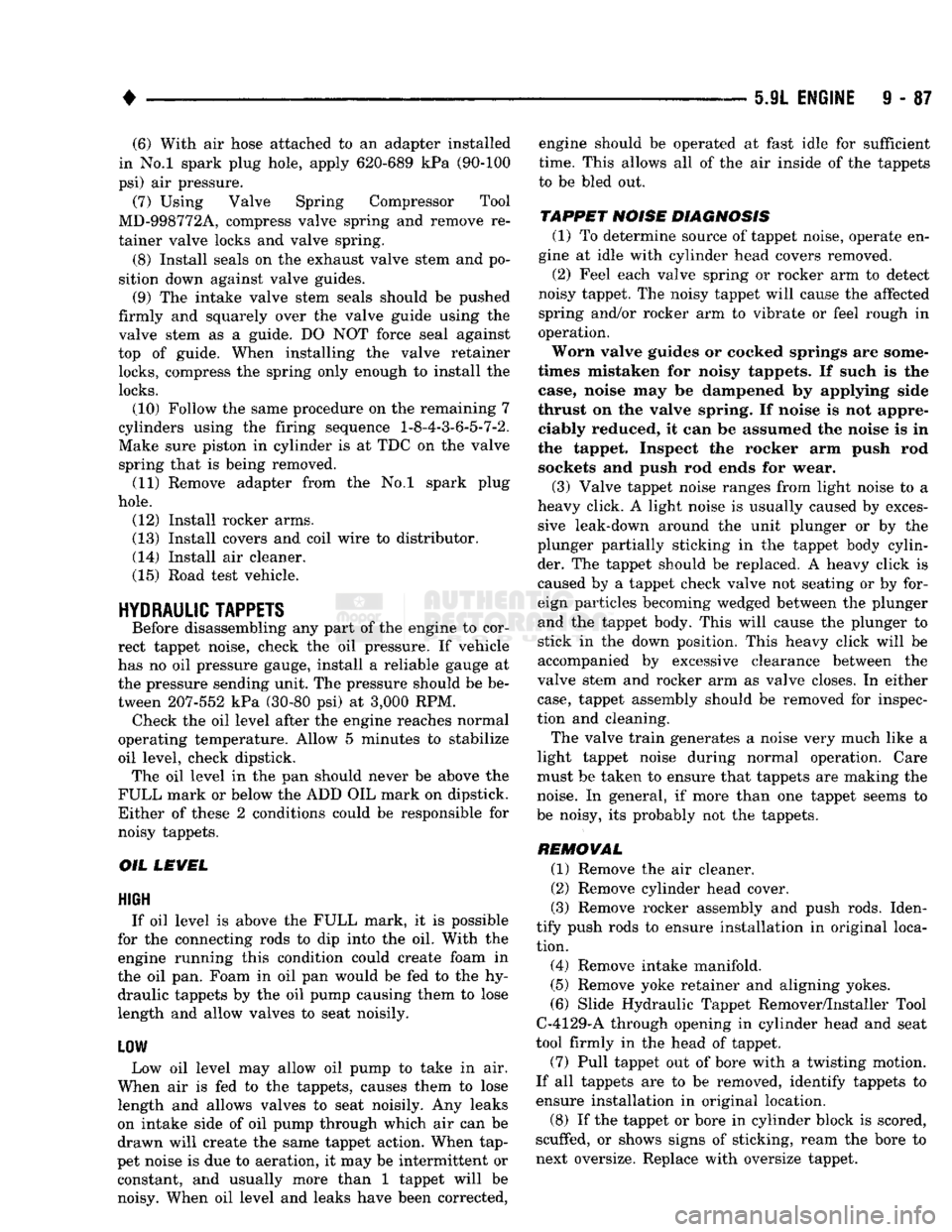
•
5.9L ENGINE
9 - 87 (6) With air hose attached to an adapter installed
in No.l spark plug hole, apply 620-689 kPa (90-100
psi) air pressure.
(7) Using Valve Spring Compressor Tool
MD-998772A, compress valve spring and remove re
tainer valve locks and valve spring.
(8) Install seals on the exhaust valve stem and po
sition down against valve guides.
(9) The intake valve stem seals should be pushed
firmly and squarely over the valve guide using the
valve stem as a guide. DO NOT force seal against
top of guide. When installing the valve retainer
locks,
compress the spring only enough to install the
locks.
(10) Follow the same procedure on the remaining 7
cylinders using the firing sequence 1-8-4-3-6-5-7-2.
Make sure piston in cylinder is at TDC on the valve spring that is being removed. (11) Remove adapter from the No.l spark plug
hole.
(12) Install rocker arms.
(13) Install covers and coil wire to distributor.
(14) Install air cleaner.
(15) Road test vehicle.
HYDRAULIC
TAPPETS
Before disassembling any part of the engine to cor
rect tappet noise, check the oil pressure. If vehicle
has no oil pressure gauge, Install a reliable gauge at
the pressure sending unit. The pressure should be be
tween 207-552 kPa (30-80 psi) at 3,000 RPM. Check the oil level after the engine reaches normal
operating temperature. Allow 5 minutes to stabilize
oil level, check dipstick. The oil level in the pan should never be above the
FULL mark or below the ADD OIL mark on dipstick.
Either of these 2 conditions could be responsible for
noisy tappets.
OIL LEVEL
HIGH
If oil level Is above the FULL mark, It is possible
for the connecting rods to dip into the oil. With the engine running this condition could create foam in
the oil pan. Foam in oil pan would be fed to the hy
draulic tappets by the oil pump causing them to lose
length and allow valves to seat noisily.
LOW
Low oil level may allow oil pump to take in air.
When air is fed to the tappets, causes them to lose length and allows valves to seat noisily. Any leaks
on intake side of oil pump through which air can be
drawn will create the same tappet action. When tap
pet noise is due to aeration, it may be intermittent or constant, and usually more than 1 tappet will be
noisy. When oil level and leaks have been corrected, engine should be operated at fast idle for sufficient
time.
This allows all of the air inside of the tappets
to be bled out.
TAPPET NOISE DIAGNOSIS
(1) To determine source of tappet noise, operate en
gine at idle with cylinder head covers removed. (2) Feel each valve spring or rocker arm to detect
noisy tappet. The noisy tappet will cause the affected
spring and/or rocker arm to vibrate or feel rough in
operation.
Worn valve guides or cocked springs are some
times mistaken for
noisy tappets.
If such is the
case,
noise may be dampened by applying side
thrust on the
valve
spring. If noise is not appre ciably reduced, it can be assumed the noise Is in
the tappet. Inspect the rocker arm push rod sockets and
push
rod ends for wear.
(3) Valve tappet noise ranges from light noise to a
heavy click. A light noise is usually caused by exces
sive leak-down around the unit plunger or by the
plunger partially sticking in the tappet body cylin der. The tappet should be replaced. A heavy click is
caused by a tappet check valve not seating or by for
eign particles becoming wedged between the plunger and the tappet body. This will cause the plunger to
stick in the down position. This heavy click will be
accompanied by excessive clearance between the
valve stem and rocker arm as valve closes. In either
case,
tappet assembly should be removed for inspec
tion and cleaning.
The valve train generates a noise very much like a
light tappet noise during normal operation. Care
must be taken to ensure that tappets are making the
noise. In general, if more than one tappet seems to
be noisy, its probably not the tappets.
REMOVAL
(1) Remove the air cleaner.
(2) Remove cylinder head cover.
(3) Remove rocker assembly and push rods. Iden
tify push rods to ensure Installation in original loca
tion.
(4) Remove Intake manifold.
(5) Remove yoke retainer and aligning yokes.
(6) Slide Hydraulic Tappet Remover/Installer Tool
C-4129-A through opening in cylinder head and seat
tool firmly in the head of tappet.
(7) Pull tappet out of bore with a twisting motion.
If all tappets are to be removed, identify tappets to ensure installation in original location.
(8) If the tappet or bore in cylinder block is scored,
scuffed, or shows signs of sticking, ream the bore to
next oversize. Replace with oversize tappet.
Page 700 of 1502
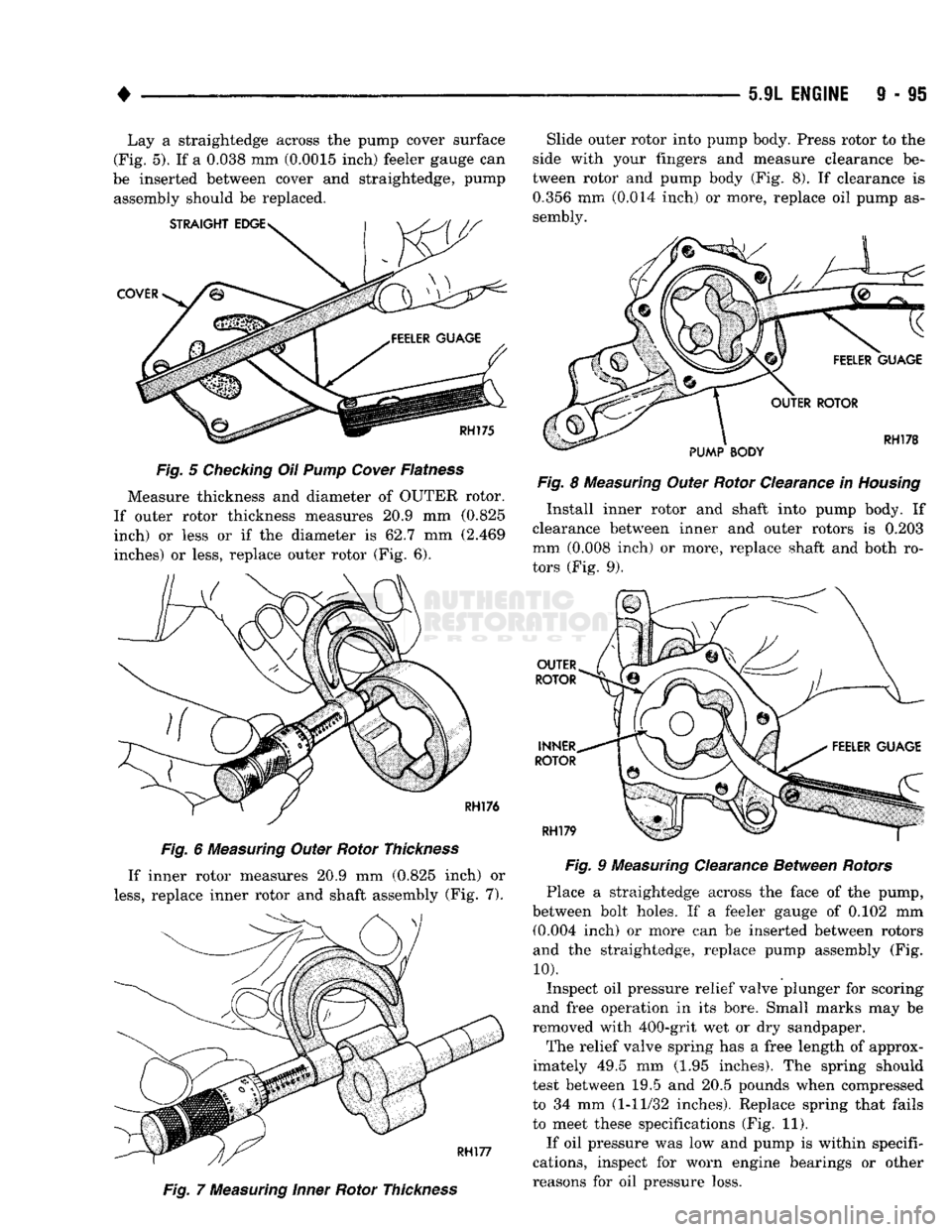
•
5.9L
ENGINE
9 - 95 Lay a straightedge across the pump cover surface
(Fig. 5). If a 0.038 mm (0.0015 inch) feeler gauge can
be inserted between cover and straightedge, pump assembly should be replaced.
Fig.
5
Checking
Oil
Pump
Cover
Flatness
Measure thickness and diameter of OUTER rotor.
If outer rotor thickness measures 20.9 mm (0.825
inch) or less or if the diameter is 62.7 mm (2.469 inches) or less, replace outer rotor (Fig. 6).
Fig.
6
Measuring
Outer Rotor
Thickness
If inner rotor measures 20.9 mm (0.825 inch) or
less,
replace inner rotor and shaft assembly (Fig. 7).
Fig.
7
Measuring
Inner
Rotor
Thickness
Slide outer rotor into pump body. Press rotor to the
side with your fingers and measure clearance be
tween rotor and pump body (Fig. 8). If clearance is 0.356 mm (0.014 inch) or more, replace oil pump as
sembly.
Fig.
8
Measuring
Outer Rotor Clearance in
Housing
Install inner rotor and shaft into pump body. If
clearance between inner and outer rotors is 0.203
mm (0.008 inch) or more, replace shaft and both ro
tors (Fig. 9).
OUTER
ROTOR
INNER
ROTOR
RH179
Fig.
9
Measuring
Clearance Between
Rotors
Place a straightedge across the face of the pump,
between bolt holes. If a feeler gauge of 0.102 mm (0.004 inch) or more can be inserted between rotors
and the straightedge, replace pump assembly (Fig.
10).
Inspect oil pressure relief valve plunger for scoring
and free operation in its bore. Small marks may be
removed with 400-grit wet or dry sandpaper.
The relief valve spring has a free length of approx
imately 49.5 mm (1.95 inches). The spring should
test between 19.5 and 20.5 pounds when compressed
to 34 mm (1-11/32 inches). Replace spring that fails
to meet these specifications (Fig. 11).
If oil pressure was low and pump is within specifi
cations, inspect for worn engine bearings or other
reasons for oil pressure loss.
Page 708 of 1502
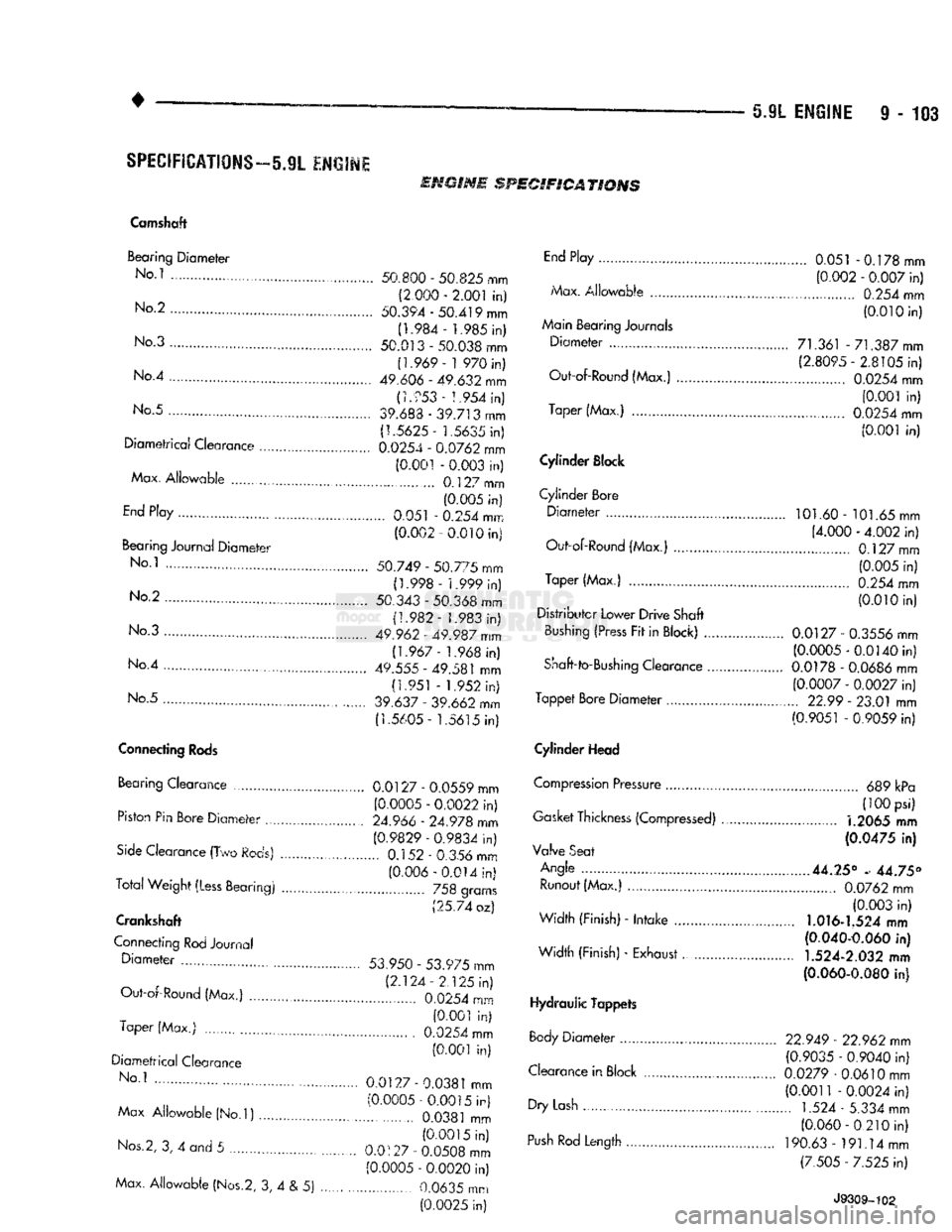
— 5.9L
ENGINE
9 - 103
SPECIFICATIONS—5.9L
ENGINE
EmmmE
SPECIFICATIONS
Camshaft
Bearing
Diameter
No i 50.800 - 50.825 mm "" (2.000 - 2.001 in)
No2
50.394-50.419 mm
' (1.984- 1.985 in)
No 3 50.013 - 50.038 mm
(1.969- 1 970 in)
No
4 49.606 - 49.632 mm
(1.953 - 1.954 in)
No
5 ................ 39.683 -39.713 mm
(1.5625-
1.5635 in)
Diametrical
Clearance 0.0254 - 0.0762 mm
(0.001 - 0.003 in)
Max.
Allowable
. 0.127 mm (0.005 in)
End
p|ay 0.051 - 0.254 mm
(0.002-0.010 in)
Bearinq
Journal
Diameter
No i 50.749 - 50.775 mm (1.998- 1.999 in)
No
2 50.343 - 50.368 mm
(1.982-
1.983 in)
No
3 . .............. 49.962 - 49.987 mm (1.967- 1.968 in)
No
4 . 49.555-49.581 mm
(1.951
- 1 952 in)
No
5 39.637 - 39.662 mm
(1.5605-
1.5615 in)
Connecting
Rods
Bearing Clearance 0.0127 - 0.0559 mm (0.0005 - 0.0022 in)
Piston Pin Bore
Diameter
24.966 - 24.978 mm
(0.9829 - 0.9834 in)
Side
Clearance (Two
Rods)
......................... 0.152 - 0.356 mm
(0.006-0.014 in)
Total
Weight
(Less
Bearing) . ... • 758 grams
(25.74 oz)
Crankshaft
Connecting
Rod
Journal
Diameter
. 53.950 - 53.975 mm (2.124 - 2.125 in)
Out-of-Round (Max.) 0.0254 mm
(0.001 in)
Taper (Max.) ... 0.0254 mm
(0.001 in)
Diametrical
Clearance
No
1
... ........ 0.0127 - 0.0381 mm (0.0005-0.0015 in)
Max
Allowable
(No.l)
- 0.0381 mm
(0.0015 in)
Nos.2,
3, 4 and 5 0.0127 - 0.0508 mm
(0.0005 - 0.0020 in)
Max.
Allowable
(Nos.2,
3, 4 & 5) ...... - 0.0635 mm (0.0025 in)
End
Play 0.051 -0.178 mm
(0.002 - 0.007 in)
Max.
Allowable
0.254 mm
(0.010 in)
Main Bearing Journals
Diameter
71.361 - 71.387 mm
(2.8095-
2.8105 in)
Out-of-Round (Max.) 0.0254 mm
(0.001 in)
Taper (Max.) .., 0.0254 mm
(0.001 in)
Cylinder Block
Cylinder
Bore
Diameter
, 101.60 - 101.65 mm (4.000 - 4.002 in)
Out-of-Round (Max.) ........... 0.127 mm
(0.005 in)
Taper (Max.) 0.254 mm
(0.010 in)
Distributor
Lower
Drive
Shaft
Bushing (Press Fit in Block) 0.0127 - 0.3556 mm (0.0005-0.0140 in)
Shaft-to-Bushing Clearance 0.0178 - 0.0686 mm (0.0007 - 0,0027 in)
Tappet
Bore
Diameter
.............. 22.99 - 23.01 mm (0.9051 - 0.9059 in)
Cylinder Head
Compression Pressure 689 kPa (100 psi)
Gasket Thickness (Compressed)
1.2065
mm
(0.0475 In)
Valve Seat
Angle .
44.25°
- 44.75° Runout (Max.) ....................... 0.0762 mm (0.003 in)
Width
(Finish) -
Intake
1.016-1.524
mm (0,040-0.060 in)
Width
(Finish) - Exhaust
1.524-2.032
mm
(0.060-0.080
in)
Hydraulic Tappets
Body
Diameter
22.949 - 22.962 mm (0.9035 - 0.9040 in)
Clearance in Block 0.0279 - 0.0610 mm
(0.0011 - 0.0024 in)
Dry
Lash
. 1.524 - 5.334 mm
(0.060-0210 in)
Push
Rod
Length
190.63 - 191.14mm
(7.505 - 7.525 in)
J9309-102
Page 709 of 1502
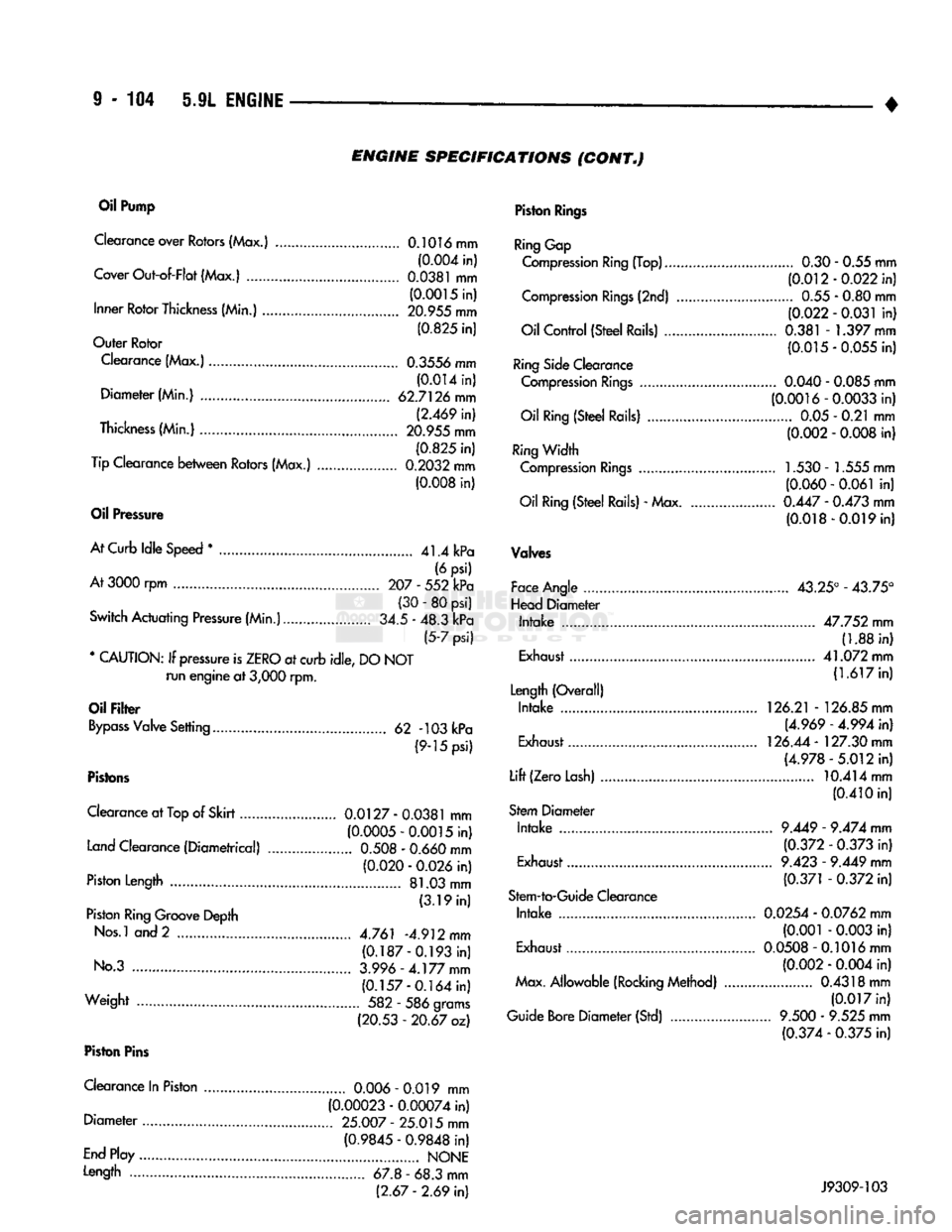
9 - 104 5.9L ENGINE
• ENGINE
SPECIFICATIONS
(CONT„)
Oil
Pump
Clearance over Rotors (Max.) 0.1016 mm (0.004 in)
Cover Out-of-Flat (Max.)
0.0381
mm (0.0015 in)
Inner Rotor Thickness (Min.) 20.955 mm
(0.825 in)
Outer Rotor
Clearance (Max.) 0.3556 mm (0.014 in)
Diameter (Min.) 62.7126 mm (2.469 in)
Thickness (Min.) 20.955 mm (0.825 in)
Tip Clearance between Rotors (Max.) 0.2032 mm (0.008 in)
Oil
Pressure
At Curb Idle Speed
*
41.4 kPa (6 psi)
At
3000 rpm 207 - 552 kPa (30 - 80 psi)
Switch Actuating Pressure (Min.) 34.5 - 48.3 kPa (5-7 psi)
* CAUTION: If pressure is ZERO at curb idle, DO NOT run engine at
3,000
rpm.
Oil
Filter
Bypass Valve Setting 62 -103 kPa (9-15 psi)
Pistons
Clearance at
Top
of Skirt 0.0127
-
0.0381
mm (0.0005-0.0015 in)
Land Clearance (Diametrical)
0.508
-
0.660
mm (0.020 -
0.026
in)
Piston Length 81.03 mm (3.19 in)
Piston Ring Groove Depth
Nos.l and 2 4.761 -4.912 mm (0.187-0.193 in)
No.3 3.996-4.177
mm
(0.157-0.164 in)
Weight 582 - 586 grams (20.53 - 20.67 oz)
Piston
Pins
Clearance In Piston
0.006
- 0.019 mm (0.00023 - 0.00074 in)
Diameter 25.007
-
25.015 mm
(0.9845 - 0.9848 in)
End Play NONE
Length 67.8 - 68.3 mm (2.67
-
2.69 in)
Piston
Rings
Ring Gap
Compression Ring (Top) 0.30 - 0.55 mm (0.012-0.022 in)
Compression Rings (2nd) 0.55 - 0.80 mm (0.022 - 0.031 in)
Oil Control (Steel Rails) 0.381 - 1.397 mm (0.015-0.055 in)
Ring Side Clearance Compression Rings
0.040
-
0.085
mm (0.0016-0.0033 in)
Oil Ring (Steel Rails) 0.05 - 0.21 mm (0.002 -
0.008
in)
Ring Width Compression Rings 1.530 - 1.555 mm (0.060 - 0.061 in)
Oil Ring (Steel Rails) - Max
0.447
-
0.473
mm (0.018-0.019 in)
Valves
Face Angle 43.25° - 43.75°
Head Diameter Intake 47.752 mm (1.88 in)
Exhaust 41.072 mm
(1.617 in)
Length (Overall) Intake 126.21 - 126.85 mm
(4.969 - 4.994 in)
Exhaust 126.44 - 127.30 mm
(4.978-5.012 in)
Lift (Zero Lash) 10.414 mm
(0.410 in)
Stem Diameter Intake
9.449
-
9.474
mm
(0.372 -
0.373
in)
Exhaust
9.423
-
9.449
mm
(0.371 -
0.372
in)
Stem-to-Guide Clearance Intake 0.0254 - 0.0762 mm (0.001 -
0.003
in)
Exhaust 0.0508-0.1016 mm
(0.002 -
0.004
in)
Max. Allowable (Rocking Method) 0.4318 mm (0.017 in)
Guide Bore Diameter (Std)
9.500
-
9.525
mm (0.374 -
0.375
in) J9309-103
Page 710 of 1502
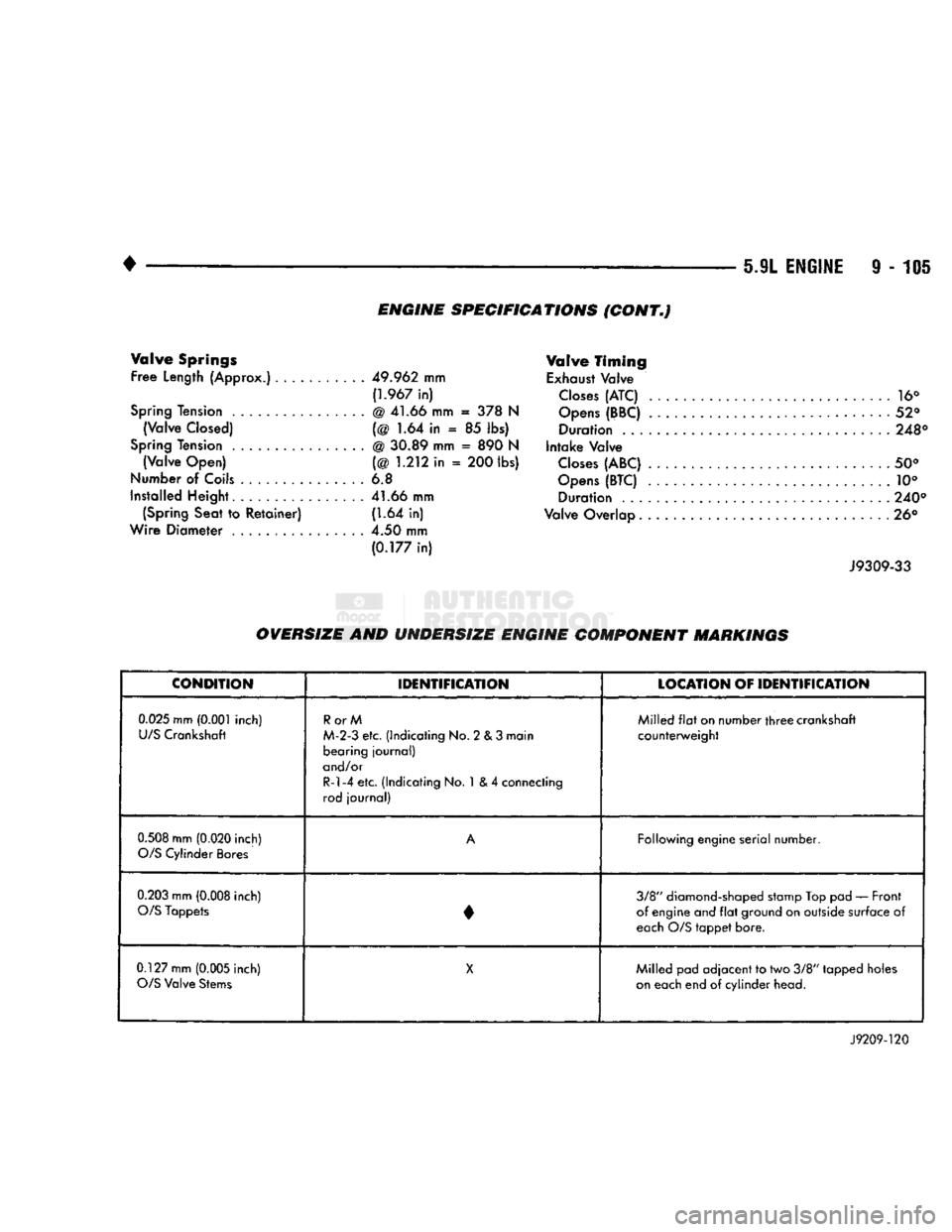
5.9L
ENGINE
9 - 105
ENGINE SPECIFICATIONS
(CONT.J
Valve
Springs
Free Length
(Approx.)...........
49.962
mm f1.967 in)
Spring
Tension ................ @ 41.66 mm = 378 N
(Valve Closed) (@ 1.64 in « 85 lbs)
Spring
Tension @ 30.89 mm = 890 N (Valve Open) (@ 1.212 in = 200 lbs)
Number of Coils ............... 6.8
Installed Height 41.66 mm (Spring Seat to Retainer) (1.64 in)
Wire Diameter ................ 4.50 mm
(0.177
in) Valve
Timing
Exhaust
Valve
Closes
(ATC) ............. 16°
Opens
(BBC) .................. ....... 52° Duration 248°
Intake Valve
Closes
(ABC) 50°
Opens
(BTC) 10° Duration ................. 240°
Valve Overlap.............................. 26°
J9309-33
OVERSIZE
AND
UNDERSIZE
ENGINE COMPONENT MARKINGS
CONDITION
IDENTIFICATION
LOCATION
OF
IDENTIFICATION
0.025
mm
(0.001
inch)
U/S
Crankshaft
RorM
M-2-3 etc. (Indicating No. 2 & 3 main bearing journal)
and/or
R-l-4 etc. (Indicating No. 1 & 4 connecting
rod journal) Milled
flat
on number
three
crankshaft
counterweight
0.508
mm
(0.020
inch)
O/S
Cylinder Bores
A
Following engine serial number.
0.203
mm
(0.008
inch)
O/S
Tappets • 3/8" diamond-shaped stamp Top pad — Front
of engine and
flat
ground on outside surface of
each O/S tappet bore.
0.127 mm
(0.005
inch)
O/S
Valve Stems
X
Milled pad adjacent to two 3/8" tapped holes
on
each end of cylinder head.
J9209-120
Page 723 of 1502

i - 118 5.9L
(DIESEL) ENGINE
VALVE GUIDE
BORES
EXHAUST CYLINDER
HEAD
INTAKE
CYLINDER HEAD VALVE GUIDE
BORES
CYLINDER HEAD VALVE GUIDE
BORES
11.125
±0.013 mm (0.438 ± 0.0005 in)
VALVE GUIDE
BORES
8.029
±0.010
mm
(0.3161 ±0.0004 in)
J9109-136
Fig.
6
Service
Valve
Guides—Thin
Wall
VALVE GUIDE
BORES
CYLINDER HEAD
EXHAUST INTAKE
CYLINDER HEAD VALVE GUIDE
BORES
CYLINDER HEAD VALVE GUIDE
BORES
14.000 ±0.013
mm
(0.5512 ± 0.0005 in)
VALVE GUIDE
BORES
8.029
±0.010
mm
(0.3161 ±0.0004 in)
J9109-137
Fig.
7
Service
Valve
Guides—Thick
Wall
VALVE
SPRINGS
Measure
the
valve spring length.
The
approximate
free length
is
55.63
mm
(2.190 inch) with
the
maxi mum inclination
of 1.0 mm
(0.039 inch).
Measure
the
valve spring force. 289.32
N (65 lbs.)
is
the
minimum acceptable load required
to
compress
the spring
to a
height
of
49.25
mm (1.94
inch). If
the
valve spring does
not
meet
the
limits above,
replace
the
spring.
VALVE
SEATS
INSPECTION
Cylinder head with integral valve seats
can be
ground only once. Previously ground integral seats
must
be
replaced with service seats. One
X
stamped into
the
head casting identify seats
that have been ground previously
(Fig. 8).
Two
X's
stamped
on the
head indicate service seats
have been installed
(Fig. 8).
Service seats
can be
ground.
SERVICE SEATS
INSTALLED
n
o
REGROUND INTEGRAL
VALVE SEAT
J9109-138
Fig.
8
Reworked
Cylinder Head
Seats—Stamped
Identification
On
the
integral seat head,
if
0.254
mm
(0.010 inch)
or more
has
been removed from
the
head combustion surface, service seats must
be
installed. To determine
if the
head
has
been previously
re
surfaced, before calculating valve depth, process
as
follows:
(1) Check
the
rear lower right corner
of the
head
for
a
stamping that would indicate previous resurfac ing
(e.g.
.003).
(2)
To
verify
the
information,
or if no
amount
is in
dicated, measure
the
head height
(Fig. 9).
(3)
If the
head height
is
94.75
mm
(3.730 inch)
or
greater,
the
valve seats
may be
ground,
if
they have
not been ground previously.
CYLINDER
HEAD
HEIGHT
J9109-139
Fig.
9
Cylinder Head Height
Page 730 of 1502
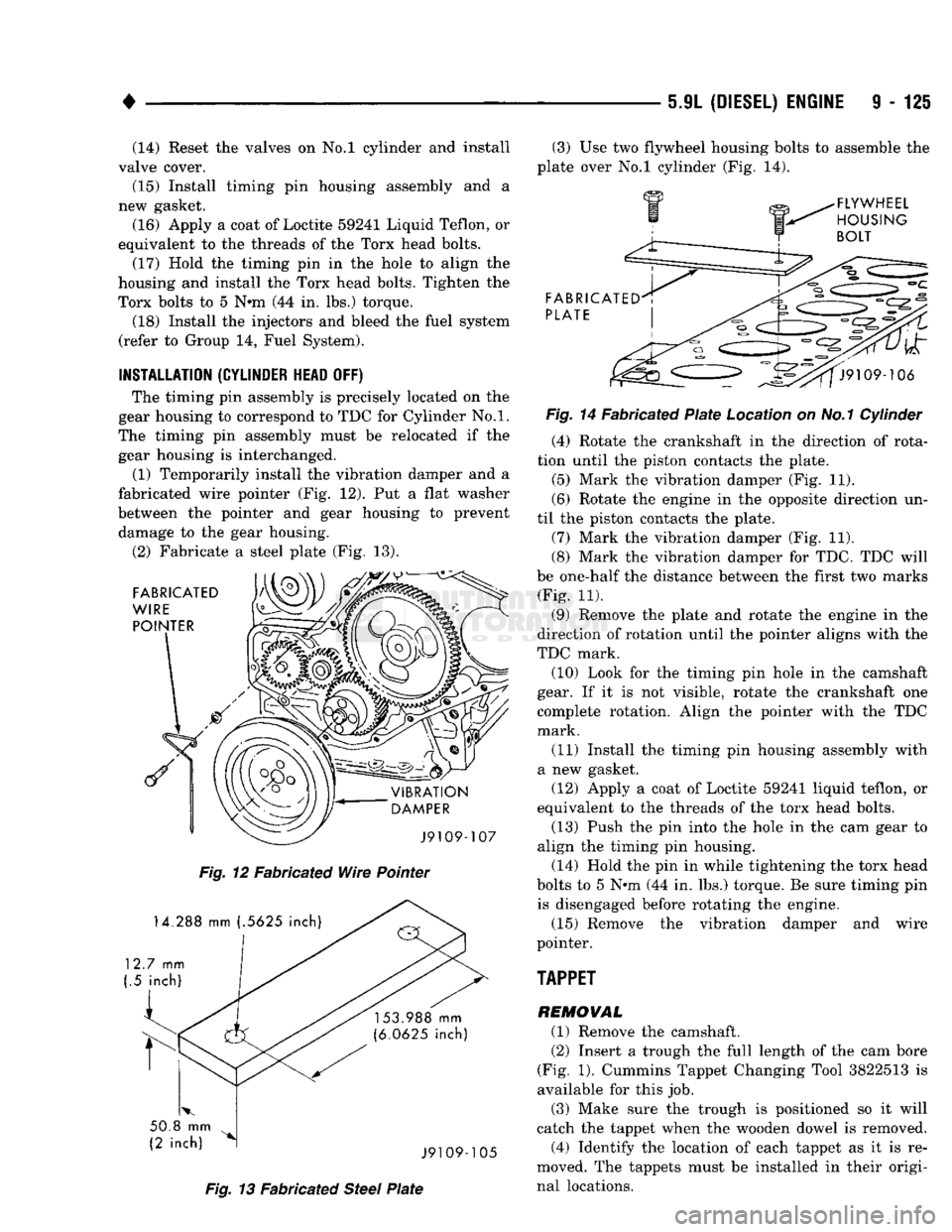
•
5JL
(DIESEL) ENGINE
9 - 125 (14) Reset the valves on No.l cylinder and install
valve cover.
(15) Install timing pin housing assembly and a
new gasket.
(16) Apply a coat of Loctite 59241 Liquid Teflon, or
equivalent to the threads of the Torx head bolts. (17) Hold the timing pin in the hole to align the
housing and install the Torx head bolts. Tighten the
Torx bolts to 5 N»m (44 in. lbs.) torque.
(18) Install the injectors and bleed the fuel system
(refer to Group 14, Fuel System).
INSTALLATION
(CYLINDER
HEAD
OFF) The timing pin assembly is precisely located on the
gear housing to correspond to TDC for Cylinder No.l.
The timing pin assembly must be relocated if the gear housing is interchanged.
(1) Temporarily install the vibration damper and a
fabricated wire pointer (Fig. 12). Put a flat washer
between the pointer and gear housing to prevent damage to the gear housing.
(2) Fabricate a steel plate (Fig. 13).
Fig.
12 Fabricated
Wire
Pointer
Fig.
13 Fabricated
Steel
Plate
(3) Use two flywheel housing bolts to assemble the
plate over No.l cylinder (Fig. 14).
Fig.
14 Fabricated
Plate
Location on No.1 Cylinder (4) Rotate the crankshaft in the direction of rota
tion until the piston contacts the plate.
(5) Mark the vibration damper (Fig. 11).
(6) Rotate the engine in the opposite direction un
til the piston contacts the plate. (7) Mark the vibration damper (Fig. 11).
(8) Mark the vibration damper for TDC. TDC will
be one-half the distance between the first two marks (Fig. 11).
(9) Remove the plate and rotate the engine in the
direction of rotation until the pointer aligns with the
TDC mark. (10) Look for the timing pin hole in the camshaft
gear. If it is not visible, rotate the crankshaft one
complete rotation. Align the pointer with the TDC
mark.
(11) Install the timing pin housing assembly with
a new gasket. (12) Apply a coat of Loctite 59241 liquid teflon, or
equivalent to the threads of the torx head bolts.
(13) Push the pin into the hole in the cam gear to
align the timing pin housing.
(14) Hold the pin in while tightening the torx head
bolts to 5 Nnn (44 in. lbs.) torque. Be sure timing pin is disengaged before rotating the engine.
(15) Remove the vibration damper and wire
pointer.
TAPPET
REMOVAL (1) Remove the camshaft. (2) Insert a trough the full length of the cam bore
(Fig. 1). Cummins Tappet Changing Tool 3822513 is
available for this job.
(3) Make sure the trough is positioned so it will
catch the tappet when the wooden dowel is removed. (4) Identify the location of each tappet as it is re
moved. The tappets must be installed in their origi
nal locations.
Page 731 of 1502
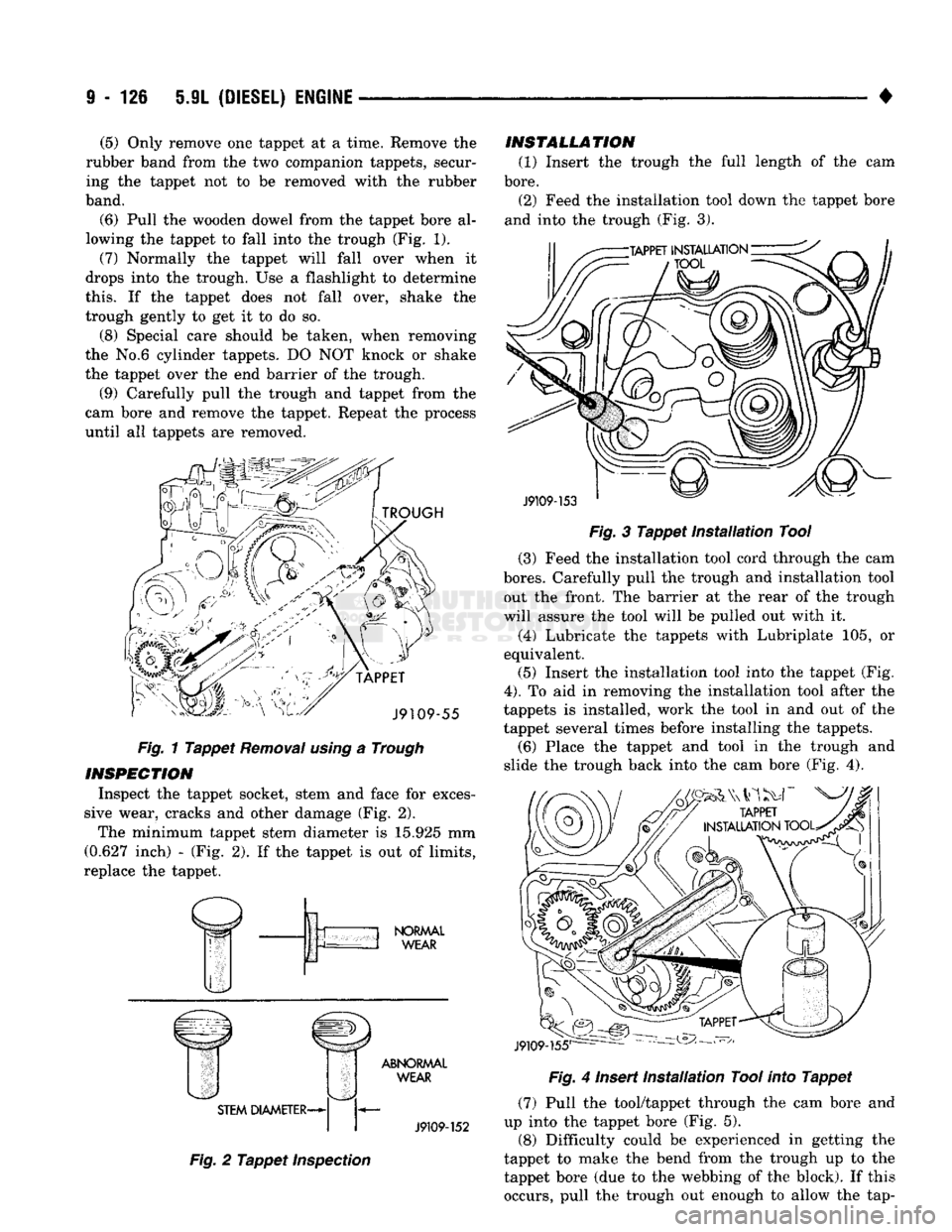
9
- 126 5.9L
(DIESEL) ENGINE
•
(5)
Only remove one tappet at a time. Remove the
rubber band from the two companion tappets, secur ing the tappet not to be removed with the rubber
band.
(6) Pull the wooden dowel from the tappet bore al
lowing the tappet to fall into the trough (Fig. 1).
(7) Normally the tappet will fall over when it
drops into the trough. Use a flashlight to determine
this.
If the tappet does not fall over, shake the
trough gently to get it to do so.
(8) Special care should be taken, when removing
the No.6 cylinder tappets. DO NOT knock or shake
the tappet over the end barrier of the trough.
(9) Carefully pull the trough and tappet from the
cam bore and remove the tappet. Repeat the process
until all tappets are removed.
Fig.
1
Tappet
Removal
using
a Trough
INSPECTION
Inspect the tappet socket, stem and face for exces
sive wear, cracks and other damage (Fig. 2).
The minimum tappet stem diameter is 15.925 mm
(0.627 inch) - (Fig. 2). If the tappet is out of limits,
replace the tappet.
NORMAL
WEAR
STEM DIAMETER-
ABNORMAL
WEAR
J9109-152
Fig.
2
Tappet
Inspection
INSTALLATION
(1) Insert the trough the full length of the cam
bore.
(2) Feed the installation tool down the tappet bore
and into the trough (Fig. 3).
J9109-153
Fig.
3
Tappet
Installation
Tool
(3) Feed the installation tool cord through the cam
bores.
Carefully pull the trough and installation tool out the front. The barrier at the rear of the trough
will assure the tool will be pulled out with it.
(4) Lubricate the tappets with Lubriplate 105, or
equivalent. (5) Insert the installation tool into the tappet (Fig.
4).
To aid in removing the installation tool after the
tappets is installed, work the tool in and out of the
tappet several times before installing the tappets. (6) Place the tappet and tool in the trough and
slide the trough back into the cam bore (Fig. 4).
J9109-155'
Fig.
4 Insert
Installation
Tool
into
Tappet
(7) Pull the tool/tappet through the cam bore and
up into the tappet bore (Fig. 5).
(8) Difficulty could be experienced in getting the
tappet to make the bend from the trough up to the tappet bore (due to the webbing of the block). If this
occurs, pull the trough out enough to allow the tap-